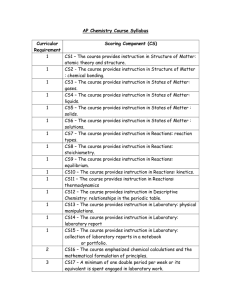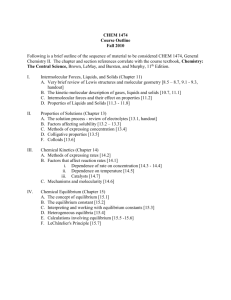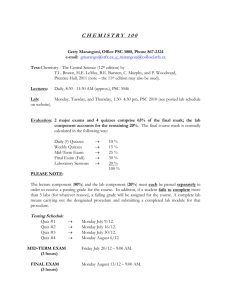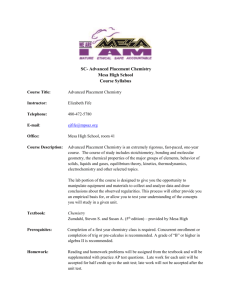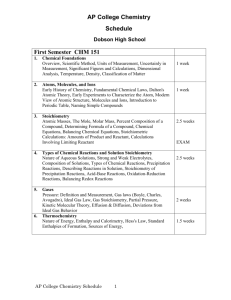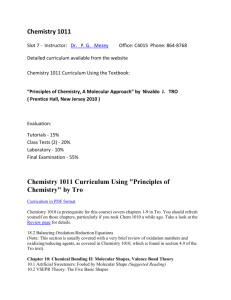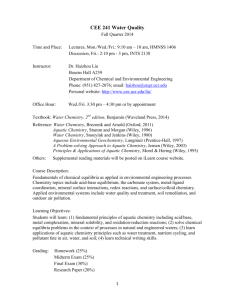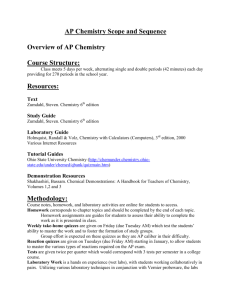AP Chemistry Syllabus
advertisement
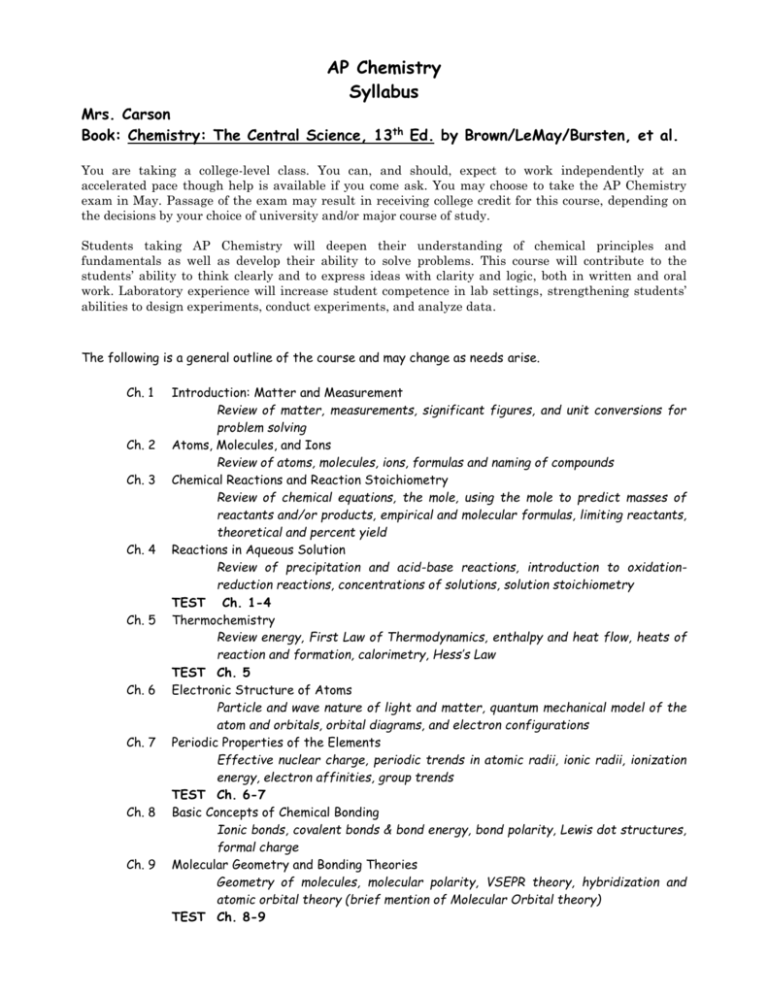
AP Chemistry Syllabus Mrs. Carson Book: Chemistry: The Central Science, 13th Ed. by Brown/LeMay/Bursten, et al. You are taking a college-level class. You can, and should, expect to work independently at an accelerated pace though help is available if you come ask. You may choose to take the AP Chemistry exam in May. Passage of the exam may result in receiving college credit for this course, depending on the decisions by your choice of university and/or major course of study. Students taking AP Chemistry will deepen their understanding of chemical principles and fundamentals as well as develop their ability to solve problems. This course will contribute to the students’ ability to think clearly and to express ideas with clarity and logic, both in written and oral work. Laboratory experience will increase student competence in lab settings, strengthening students’ abilities to design experiments, conduct experiments, and analyze data. The following is a general outline of the course and may change as needs arise. Ch. 1 Ch. 2 Ch. 3 Ch. 4 Ch. 5 Ch. 6 Ch. 7 Ch. 8 Ch. 9 Introduction: Matter and Measurement Review of matter, measurements, significant figures, and unit conversions for problem solving Atoms, Molecules, and Ions Review of atoms, molecules, ions, formulas and naming of compounds Chemical Reactions and Reaction Stoichiometry Review of chemical equations, the mole, using the mole to predict masses of reactants and/or products, empirical and molecular formulas, limiting reactants, theoretical and percent yield Reactions in Aqueous Solution Review of precipitation and acid-base reactions, introduction to oxidationreduction reactions, concentrations of solutions, solution stoichiometry TEST Ch. 1-4 Thermochemistry Review energy, First Law of Thermodynamics, enthalpy and heat flow, heats of reaction and formation, calorimetry, Hess’s Law TEST Ch. 5 Electronic Structure of Atoms Particle and wave nature of light and matter, quantum mechanical model of the atom and orbitals, orbital diagrams, and electron configurations Periodic Properties of the Elements Effective nuclear charge, periodic trends in atomic radii, ionic radii, ionization energy, electron affinities, group trends TEST Ch. 6-7 Basic Concepts of Chemical Bonding Ionic bonds, covalent bonds & bond energy, bond polarity, Lewis dot structures, formal charge Molecular Geometry and Bonding Theories Geometry of molecules, molecular polarity, VSEPR theory, hybridization and atomic orbital theory (brief mention of Molecular Orbital theory) TEST Ch. 8-9 Ch. 10 Gases Review of gas laws under ideal conditions, mole fraction in gas mixtures, kinetic molecular theory of gases, and deviation from ideal gas behavior Ch. 11 Liquids and Intermolecular Forces Properties of liquids, energetics of changes in state, intermolecular forces, phase diagrams Ch. 12 Solids and Modern Materials Metallic solids, ionic solids, molecular solids, covalent-network solids Ch. 13 Properties of Solutions Solution process, factors affecting solubility, saturation, solution concentration TEST Ch. 10, 11, 12 & 13 Ch. 14 Chemical Kinetics Concept of rate of reaction, rate expressions, rate constants, orders of reactions, collision model, activation energy, reaction mechanisms, catalysts TEST Ch. 14 Ch. 15 Chemical Equilibrium Concept of dynamic equilibrium, equilibrium constants, LeChatelier’s principle Ch. 17 Additional Aspects of Aqueous Equilibria (Sect. 17.4 - 17.7 only) Solubility equilibria and Ksp, selective precipitation TEST Ch. 15 & 17.4-17.7 Ch. 16 Acid-Base Equilibria Arrhenius, Bronsted-Lowry and Lewis acids and bases; pH and pOH, weak acid and bases; hydrolysis of salts; molecular structures of acids and bases Ch. 17 Additional Aspects of Aqueous Equilibria (Sect. 17.1 - 17.3 only) Common ion effect, buffers, acid-base titrations, and indicators TEST Ch. 16-17 (acid/base topics only) Ch. 19 Chemical Thermodynamics Factors in spontaneity of reactions, entropy, Gibbs free energy, standard free energy change, free energy and the equilibrium constant Ch. 20 Electrochemistry Oxidation and reduction, balancing redox equations, voltaic and electrolytic cells, standard half-cell potentials TEST Ch. 19-20 Ch. 23 Chemistry of Coordination Compounds (if there is enough time) Metal complexes, ligands, chelating agents, coordination numbers, geometry of coordination complexes, crystal field theory TEST Ch. 23 AP Exam and Final Exam Preparation Prepare for AP exam/final exam AP CHEMISTRY EXAM / FINAL EXAM Qualitative Analysis Laboratory Identification of an unknown using techniques from qualitative analysis Independent Research Topic Research the chemistry of a topic of importance in modern living: write a paper and deliver an oral/visual presentation of the research
